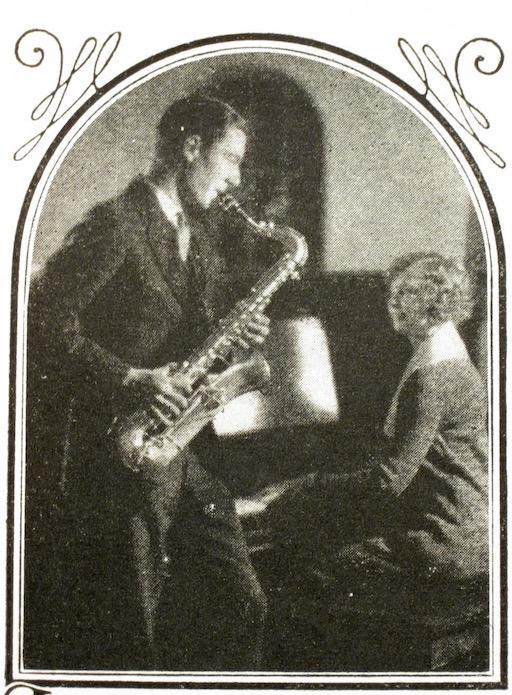
How It Came To Be: Morgan C-Melody Tenor Mouthpiece
Share
The C-Melody saxophone is a C pitched saxophone that was popular in the 1910s - 1920s. For the most part, it was considered a parlor or home instrument. At the time, many homes already had a piano and lots of piano music. A saxophone pitched in C allowed the player to read melody lines from piano and voice sheet music. While popular throughout much of the 1920s, their popularity waned in the late 1920s  and by the early 1930s, most manufacturers had ceased production of them. Many of the 1920s C-Melody saxophones are still in remarkable condition since most were only played for a few years and many were played at home. The craftsmanship on many of them is just as good as the manufacturers’ professional alto and tenor models.
and by the early 1930s, most manufacturers had ceased production of them. Many of the 1920s C-Melody saxophones are still in remarkable condition since most were only played for a few years and many were played at home. The craftsmanship on many of them is just as good as the manufacturers’ professional alto and tenor models.
Fast forward to the late 1990s and early 2000s. With the rise of the internet (special thanks to Al Gore), and the popularity of worship music in churches, C-Melody saxophones made a comeback. The old Conn, Buescher and Martin C-Melody Tenor saxes became somewhat  popular for worship and small combo music as the saxophonist could read the piano music and play in the same key without transposing.
popular for worship and small combo music as the saxophonist could read the piano music and play in the same key without transposing.
 The other options were original C-Melody mouthpieces from the 1920s. These all had very small tip openings. They had huge interior chambers which caused them to blow stuffy. They were designed to use C-Melody reeds which are no longer available today. A good craftsman could open the mouthpiece up a bit, but it was still a 1920s huge interior mouthpiece with little power and lots of stuffiness.
The other options were original C-Melody mouthpieces from the 1920s. These all had very small tip openings. They had huge interior chambers which caused them to blow stuffy. They were designed to use C-Melody reeds which are no longer available today. A good craftsman could open the mouthpiece up a bit, but it was still a 1920s huge interior mouthpiece with little power and lots of stuffiness.
As the C-Melody saxophone became more popular again, Erik Greiffenhagen realized the need for a good professional C-Melody mouthpiece. He set out to design and produce a top-quality hard rubber mouthpiece specifically designed to work with C-Melody tenor saxophones. He designed the interior specifically for a  C-Melody saxophone. The interior is designed to allow the C-Melody to sing like never before while maintaining intonation. The facing curve is designed to use standard Bb tenor reeds. The chamber is a medium/large chamber and the mouthpiece has a slight roll-over baffle. This design gives the mouthpiece more power than the old mouthpieces, but with better intonation than modern mouthpieces.
C-Melody saxophone. The interior is designed to allow the C-Melody to sing like never before while maintaining intonation. The facing curve is designed to use standard Bb tenor reeds. The chamber is a medium/large chamber and the mouthpiece has a slight roll-over baffle. This design gives the mouthpiece more power than the old mouthpieces, but with better intonation than modern mouthpieces.
The Morgan C-Melody facing curve is “chart-designed” for Bb tenor reeds. This facing curve allows modern Bb Tenor reeds to work more efficiently than the 1920s facing curves designed for C-Melody reeds.
 The material used to make the Morgan C-Melody Mouthpiece is the Morgan Company’s own rubber formula. This formula is very much like the old rubber formula used for the original 1920s mouthpieces. It is a pure rubber with no synthetic materials added. Many of the modern C-Melody mouthpieces from other manufacturers are made of plastic or rubber with lots of synthetic additives.
The material used to make the Morgan C-Melody Mouthpiece is the Morgan Company’s own rubber formula. This formula is very much like the old rubber formula used for the original 1920s mouthpieces. It is a pure rubber with no synthetic materials added. Many of the modern C-Melody mouthpieces from other manufacturers are made of plastic or rubber with lots of synthetic additives.
Erik Greiffenhagen designed this mouthpiece and Ralph Morgan approved it. Production started and players were finally realizing the full potential of their old C-Melody saxophone.
We truly believe it is the best C-Melody Tenor Mouthpiece ever made. This is a pure hard rubber mouthpiece. It is specifically designed for C-Melody Tenor saxophones. It is designed to use modern Bb reeds. It is available in several playable openings. The interior design allows for more dynamic range than the early mouthpieces. As far as we know, there is no comparable C-Melody mouthpiece on the market. If you are a C-Melody player, this is a mouthpiece you must try. If you have a C-Melody saxophone that you don’t play, try one of these mouthpieces and discover the unrealized potential your horn has.
Click the following link for more information:
Morgan C-Melody Tenor Saxophone Mouthpiece Product Page

3 comments
I have a rebuilt Buescher ca 1924 True Tone Low Pitch C melody. What would be the recommended tip opening I should order for best projection and response?
I’ve owned and played over a dozen different kinds of C melody sax mouthpieces extensively, including 1920s Conn, Buscher Goldbeck and Martin mouthpieces with varied tip openings, and a modern Babbitt. I’ve also tried alto and tenor sax mouthpieces on the six different C melody saxes I’ve owned over the years – Two Martins, two Conns, a Buescher, and a Selmer. Nothing compares to the Morgan C melody mouthpiece. It is the best by far.
I’ve owned and played over a dozen different kinds of C melody sax mouthpieces extensively, including 1920s Conn, Buscher Goldbeck and Martin mouthpieces with varied tip openings, and a modern Babbitt. I’ve also tried alto and tenor sax mouthpieces on the six different C melody saxes I’ve owned over the years – Two Martins, two Conns, a Buescher, and a Selmer. Nothing compares to the Morgan C melody mouthpiece. It is the best by far.